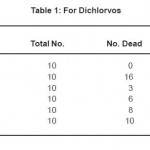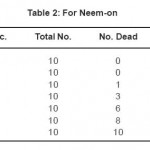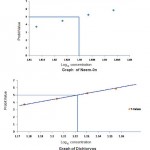A Comparative Study on the Toxicity of a Synthetic Pesticide, Dichlorvos and a Neem based Pesticide, Neem-On to Labeo rohita (Hamilton)
Bilal Ahmad Bhat1 * , Imtiyaz Ahmad Bhat1 , Santosh Vishwakarma1 , Alok Verma2 and Geeta Saxena1
1
Department of Zoology,
Govt. Science and Commerce College Benazir,
Bhopal,
462 008
India
2
Department of Zoology,
Govt. College Lateri vidisha,
464 114
India
DOI: http://dx.doi.org/10.12944/CWE.7.1.24
Fish and other organisms are affected by pesticides which pollute the natural water through agricultural runoff. Fishes are common bioindicators of water pollution. In the present study bioassay of synthetic pesticide, Dichlorvos and a plant origin natural pesticide, Neem-On was separately done on Labeo rohita. Data obtained from the toxicity tests were evaluated using the Probit Analysis Statistical Method. The 96h LC50 of Dichlorvos and Neem-On was found to be 16.71ppm, 42.66ppm respectively. The fish exhibited erratic swimming, copious mucus secretion, loss of equilibrium and hitting to the walls of test tank prior to mortality. In this study, Neem-On was less toxic to fish as compared to Dichlorvos. Plant based pesticides are biodegradable and are target specific than the highly persistent broad spectrum synthetic chemicals. Therefore, use of plant based pesticides is less disastrous and more ecofriendly.
Copy the following to cite this article:
Bhat BA, Bhat IA, Vishwakarma S, Verma A, Saxena G. A Comparative Study on the Toxicity of a Synthetic Pesticide, Dichlorvos and a Neem based Pesticide,Neem-On to Labeo rohita ( Hamilton ). Curr world Environ 2012;7(1):157-161 DOI:http://dx.doi.org/10.12944/CWE.7.1.24
Copy the following to cite this URL:
Bhat BA, Bhat IA, Vishwakarma S, Verma A, Saxena G. A Comparative Study on the Toxicity of a Synthetic Pesticide, Dichlorvos and a Neem based Pesticide,Neem-On to Labeo rohita ( Hamilton ). Curr world Environ 2012;7(1):157-161. Available from: http://cwejournal.org?p=369/
Download article (pdf)
Citation Manager
Publish History
Select type of program for download
| Endnote EndNote format (Mac & Win) | |
| Reference Manager Ris format (Win only) | |
| Procite Ris format (Win only) | |
| Medlars Format | |
| RefWorks Format RefWorks format (Mac & Win) | |
| BibTex Format BibTex format (Mac & Win) |
Article Publishing History
| Received: | 2012-02-15 |
|---|---|
| Accepted: | 2012-03-29 |
Introduction
Increased used of pesticide results in the excess inflow of toxic chemicals, mainly in to the aquatic ecosystem (Baskaran et al., 1989; Kalavanthy et al., 2001). The aquatic environment is currently under threat by the indiscriminate use of synthetic pesticides by the human activities and causing high risk to non-target organisms (Kumar et. al., 2010). Among different classes of pesticides, organophosphates are more frequently used, because of their high insecticidal property, low mammalian toxicity, less persistence and rapid biodegradability in the environment (Singh et al., 2010). Dichlorvos is recommended for application as a high or a low volume spray on crops such as paddy, wheat, soyabean, apple, sugarcane, mustard, sunflower and cashew. The Environment Protection Agency (EPA) has classified dichlorvos as toxicity class 1 highly toxic (URL: 1). Several species of fish are susceptible to deleterious effects when exposed to heavy metals, pesticides and other environmental stressors (Khangrat et al., 1988; Areechon and Plump, 1990).
To overcome the hazardous effects of these organic pesticides, recent emphasis is on the use of natural pesticides, which are usually of plant origin. Some plants contain compounds of various classes that have insecticidal, piscicidal and molluscicidal properties. Unlike synthetic chemical pesticides, which leave harmful residues in the aquatic environment (Koesomadinata, 1980; Cagauan, 1990; Cagaun and Arce, 1992) botanical insecticides are believed to be more environmentally friendlier because they are easily biodegraded and leave no residues in the environment. Azadirachtin derived from neem (Azadirachta indicaA. Juss) is a very effective and extensively used pesticide. Pesticides based on azadirachtin may have direct adverse effects on aquatic organisms and their toxicity depends on various factors. It has been reported that neem extracts in aquatic environments are lethal to benthic populations and drastically decrease the number of organisms in the food web and nutrient cycling process (Goktepe et al., 2002; El-Shazly et al., 2000). Pesticides containing bioactive compounds from the neemplant, Azadirachta indica Juss are reported to be target specific and comparatively less toxic.
However little work has been done on the toxic effect of neem based pesticides on fish. It is possible to substitute organic pesticides with the pesticides of plant origin. Hence the present study was carried out to evaluate the comparative effect of organophosphate pesticide Dichlorvos and neembased pesticide Neem-On to Labeo rohita (Ham.).
Material and Methods
Healthy and active adult Labeo rohita were obtained from Patra fish farm barkhedi Bhopal (M.P). They weighed 55g±1g and their length was in the range 15cm±1. They were brought to laboratory carefully in oxygen filled polythene bags in card board boxes to avoid any injury and disinfected by giving a bath for five minutes in KMno4 solution. Thereafter, they were transferred to glass aquariums filled with dechlorinated water. The fishes were acclimated to the laboratory conditions for at least 20 days prior to the experiment. During acclimatization fishes were fed daily with commercial fish food which was given at morning hours. Water was replaced every 24h after feeding in order to maintain a healthy environment for the fish during acclimation and experimental period.
This ensures sufficient oxygen supply for the fish and the environment is devoid of any accumulated metabolic wastes. Dead fishes when ever located were removed immediately to avoid fouling of the water.
Water quality characteristics were determined and maintained. Nuvan (dichlorvos 76% EC) manufactured by Syngenta India ltd. 14, J. Tata road, Mumbai and Neem-On Manufactured by Jai Kissan Agro Pvt. Ltd., Sangam nagar, Indore, (M.P.) purchased from local market were used for evaluation of their toxicity to fish. . For determining LC50 concentration different stock solutions were prepared, separate glass aquariums were taken and different concentrations of Dichlorvos and Neem-on were added from the stock solution. Simultaneously a control set was run with the experiment. During assay no food was administered to fishes. The LC50 concentration for 96h was calculated by probit analysis method of Finney’s (1971). The control, Neem-On and Dichlorvos exposed fish were kept under continuous observation during experimental periods.
Results
The 96h LC50 value of Dichlorvos and Neem-On was found to be 16.71ppm and 42.66ppm respectively. The LC50 concentration for 96h was calculated by probit analysis method of Finney’s (1971). Table 1 and 2 shows the relation between the Dichlorvos, Neem-On concentration and the mortality rate of Labeo rohita and the graphs below show the plot of Finney’s probits against log10 conc. for calculating LC50 value of both the pesticides.
 |
Table 1: For Dichlorvos Click here to View table |
 |
Table 2: For Neem-on Click here to View table |
After exposure of both the pesticides, the Labeo rohita showed behavioral changes, they aggregated at one corner of aquarium, irregular, erratic and darting swimming movements and loss of equilibrium. They slowly became lethargic, hyper excited, restless and secreted excess mucus all over their bodies. The fish exhibited peculiar behavior of trying to leap out from the pesticide medium which can be viewed as an escaping phenomenon. They often spiral rolled at intervals and finally the fishes sank to bottom with their least operculum movements and died with their mouth opened. However, the behavioral changes were more prominent for the synthetic pesticide Dichlorvos as compared to Neem-on.
 |
Graph of Neem-0n and Graph of Dichlorvos Click here to View graphs |
Discussion
Newer biological pesticides are developed to replace deleterious chemical pesticides. Even though chemical pesticides are target specific and effective, their impact on the environment is mostly deleterious. Plant based pesticides contain active principles with low half-life period and their effects on the environment are not too detrimental (Sharma et al., 1995). In the present study, the pesticide containing azadirachtin is less toxic to fish compared to Dichlorvos. The 96h LC50 of Dichlorvos is 16.71 ppm. Whereas azadirachtin is much higher 42.66ppm indicating the less toxic nature of the plant based pesticide. Das et al., 2002 have studied the acute toxicity of neem in the fingerlings of Indian major carps i.e., Labeo rohita, Catla catla and Cirrhinus mrigala and the 96h LC50 values were found to be 2.36, 2.04 and 2.78ppm respectively. Hassanein et al., 2007 reported the 96h LC50 value of a neem biopesticide (Triology) on the grass carp fish, Ctenopharyngodon idella and was found to be 112ppm. Cagauan et al. (2004) showed that the lethal concentration of neem to Nile tilapia Oreochromis niloticus L. was 12.4 ml/L and mosquito fish Gambusia affinis Baird and Girard was 8.31 ml/L and the corresponding 96 h LC50 values were 2.57 and 3.0 ml/L). The LC50 values of Dichlorvos has been reported by various workers as in Cyprinus carpio 6gm it was 0.34ppm for 96h (Verma et al., 1981) in Cirrhinus mrigala it was 9.1ppm for 96h (Velmurugan et al., 2009) and in Ctenopharyngodon idella it was 13.1ppm for 24h (K.S Tilak and Swarna Kumari 2009).
Comparison of the LC50 values clearly indicates that the plant based pesticide is less toxic compared to the chemical one. To reduce the chemical load on the environment, it is suggested that use of plant based pesticides should be encouraged (Schmutterer, 1990). However, care should be taken to use even the plant based pesticide at moderate levels. Furthermore, plant based pesticides disintegrate easily into constituent elements without leaving any indelible impression in different regions of the environment (Khan and Ahmed, 2000). It is advocated that more and more plant products should be developed with proper and targeted action and this eventually helps in keeping the environment free from hazardous chemicals. From the present study, it could be concluded that Dichlorvos contamination is dangerous to aquatic ecosystems, and this fact should be taken into consideration when this insecticide is used in agriculture or in the control of mosquito populations. It can be also concluded that although neem based pesticides are considered as less toxic and environmental friendly, but precautions must be taken when it is used in fish inhabiting areas since the excess application can affect the life of organisms. This type of study can also be useful to compare the sensitivity of the various species of aquatic animals and potency of chemicals using LC50 values and to derive safe environvimental concentration by which there is no lethality and stress to the animals.
References
- Areechon, N. and Plump, J.A., Sub lethal effects of Malathion on channel cat fish, Ictalaurus punctatus. Bull. Environ. Contam.Toxicol., 44: 435-442 (1990).
- Baskaran, P., Palanichamy, S., Visalakshi, S. and Balasubramanian, M.P. Effects of mineral fertilizers on survival of the fish Oreochromis mossambicus. Environ. Ecol., 7: 463-465 (1989).
- Cagauan, A.G., The impact of pesticides on rice fields vertebrates with emphasis on fish. In: P.L. Pingali and P.A. Roger (Eds.), Impact . of pesticides on farmer health and the rice environment. International Rice Research Inst., Kluwer Academic Publ., Phillipines: 203-248 (1990).
- Cagauan, A.G. and Arce, R.G., Overview of pesticides use in rice-fish farming in South East Asia. In: C.R. Dela cruz, C. Lightfood, B. Coasta pierce, V.R. Carangal and M.P. Bimbao (Eds.), Rice-fish research and development in Asia. International Centre for Living Aquatic Resources Management (ICLARM) Conf. roc., Philippines: 24: 217-233 (1992).
- Caguan, A.G., Galaites, M.C. and Fajardo, L.J., Evaluation of botanical piscicides on Nile tilapia Oreochromis niloticus L. and mosquito fish Gambusia affinis Baird and Girard. Proceedings on ISTA, 12-16 September. Manila, Phillipines: 179-187 (2004).
- Das, B. K., Mukherjee, S. C., and Murjani, O. Acute toxicity of neem (Azadirachta indica) in Indian major carps. Journal of Aquaculture in the Tropics, 17: 23-33 (2002).
- El-Shazly, M.M. and El-Sharnoubai, E.D. , Toxicity of a neem (Azadirachta indica) insecticide to certain aquatic organisms. Journal of the Egyptian Society of Parasitology, 30(1): 221-231.
- Finney, D.J., Probit analysis, 3rd (Ed.), Cambridge University Press, London, 333 pp (1971).
- Goktepe, I. and Pihak, L.C., Comparative toxicity of two azadirachtin – based neem pesticides to Daphnia pulex. Environmental Toxicology and Chemistry, 21(1): 31-36 (2002).
- Hassanein, H. M. A; Okail, H. A. and Mohamed, N.K. Biochemical changes in proteins and DNA in Ctenopharyngodon idella due to environmental pollution with the biopesticide (Trilogy). 10 ICCA, Garyounis University, Benghazi, Libya: 18-21 (2007).
- Kumar A., Prasad, M.R., Srivastava, K., Tripathi, S. and A.K., Srivastava., Branchial Histopathological Study of catfish Heteropneustes fossilis following exposure to purified Neem Extract, Azadirachtin. World journal of zoology. 5 (4): 239-243 (2010).
- Kalavathy, K., Sivakumar, A.A. and Chandran, R., Toxic effect of the pesticide Dimethoate on the fish Sarotherodon mossambicus. J. Ecol. Res. Bioconserv., 2(1-2): 27–32 (2001).
- Khan, M.F. and Ahmed, S.M., Toxicity of crude neem leaf extract against housefly Musca domestica L. adults as compared with DDVP, Dichlorvos. Turk. J. Zool., 24(4): 219-223 (2000).
- Khangarot, B.S., Ray, P.K. and Singh, K.P. Influence of copper treatment on the immune response in an air breathing teleost Saccobranchus fossilis. Bull. Environ. Contam. Toxicol., 41: 222-226 (1988).
- Koesomadinata, S., Pesticide as a major constraint in integrated agriculture-aquaculture farming system. In: R.S.V. Pullin and Z.H. Shehadeh (Eds.), Integrated Agriculture - Aquaculture Farming Systems. (ICLARM) Conf. Proc., 4: 45-51 (1980).
- Schmutterer, H., Properties and potential of natural pesticides from the neem tree, Azadirachta indica. Ann. Rev. Entomol., 35:271-297 (1990).
- Sharma, S.K., Dua, V.K. and Sharma, V.P., Field studies on the repellent action of neem oil. Southeast Asian. J. Trop. Med. Pub. Helth.,26: 180-182 (1995).






